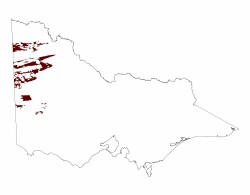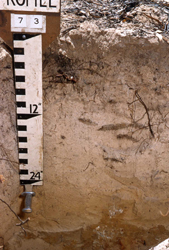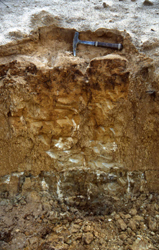5.2.2 Linear dunes and sandplains (Little Desert, Sunset Desert and eastern Big Desert)
5. North Western Dunefields and Plains (DP)
5.2 Siliceous dunefields (Sunset, Big and Little Desert)
| Linear dunefields with mostly narrow, sandy swales occupy most of the Little Desert, more than half of the Sunset Desert, and about half of the Big Desert. The dunes tend to be low, smooth-crested and wavy, with an overall east-west alignment. These dunefields overlie similar landforms to those beneath 5.2.1. An exception is to the east of Lake Wirrengren where the dunes cover several lunettes, extending some 40 km from the present lake bed. In low sites such as broad regional depressions and plains between stranded ridges the Lowan Sand may be shallow or absent, exposing fluvial or lacustrine sediments. Around the desert margins, reddish materials are common on broad flats, representing the aeolian Woorinen Formation. Soils developed within Lowan Sand have significant profile development both on dunes and swales. Below the surface layer with humus accumulation the A horizon is an off-white sand, mostly more than 1 m thick. There is a sharp change to yellowish-red, somewhat compact clayey sand B horizons with yellow and grey mottles. Reaction in the profiles examined was neutral in the upper sands and alkaline in the B horizons. Soluble salt contents were low throughout. The physical features of the soils are those of Podosols, but this categorisation is precluded by the neutral to alkaline reaction. It seems that Podosols originally developed on Lowan Sand have been modified by accessions of calcareous dust. |  |
Diverse soils have been noted in the scattered low sites where the Lowan Sand is shallow or absent including Sodosols, grey weakly-structured Vertosols and Calcarosols around desert margins in the north.
Vegetation on the dunes and sandy swales is mostly mallee with prominent shrub understorey of genera such as Leptospermum, Callitris, Baeckea and Melaleuca. On flats lacking Lowan Sand the mallee stands are taller and have sparse understorey. In the drier Sunset Desert the common pattern is small mallee and Spinifex grass on the dunes, mallee with the shrub Leptospermum on sandy swales, and mallee with sparse understorey in the lowest sites with heavier soils.
 Pale siliceous sand on interdune flat in the Big Desert. Note the compact yellow B horizon at approximately 1 m depth. |  Sodosol in a locally low situation in the Big Desert south of Murrayville. Pale siliceous sand overlies compact sandy clay lagoonal deposits. |


